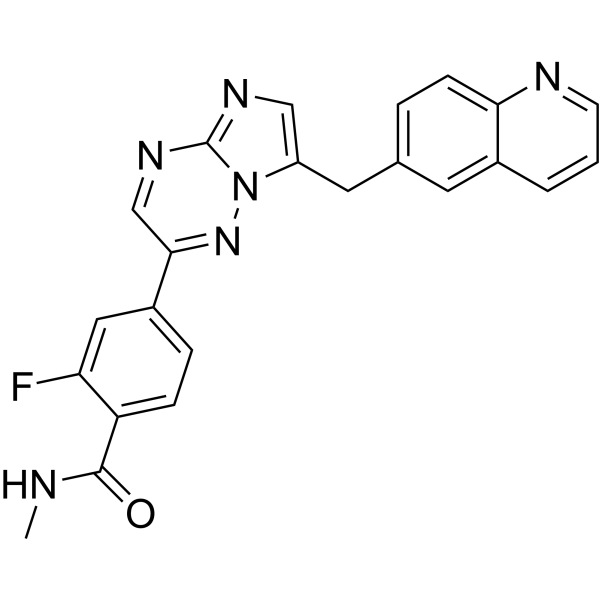Home
Products
Capmatinib (INCB28060)



| Product Name | Capmatinib (INCB28060) |
| Price: | Inquiry |
| Catalog No.: | CN00314 |
| CAS No.: | 1029712-80-8 |
| Molecular Formula: | C23H17FN6O |
| Molecular Weight: | 412.42 g/mol |
| Purity: | >=98% |
| Type of Compound: | Alkaloids |
| Physical Desc.: | Powder |
| Source: | |
| Solvent: | Chloroform, Dichloromethane, Ethyl Acetate, DMSO, Acetone, etc. |
| SMILES: | CNC(=O)c1ccc(cc1F)c1cnc2n(n1)c(cn2)Cc1ccc2c(c1)cccn2 |
| Contact us | |
|---|---|
| First Name: | |
| Last Name: | |
| E-mail: | |
| Question: | |
| Description | Capmatinib (INCB28060) is a potent and selective c-MET kinase inhibitor. Capmatinib (INCB28060) inhibits c-MET kinase activity with an average IC50 of 0.13 nM. |
| Target | IC50: 0.13 nM (c-MET)[1] |
| In Vitro | Capmatinib (INCB28060) inhibits c-MET phosphorylation with an IC50 value of approximately 1 nM and a concentration of approximately 4 nM inhibits c-MET more than 90%. Capmatinib (INCB28060) inhibits SNU-5 viability or proliferation with an average IC50 value of 1.2 nM and a calculated IC90 value of 4.6 nM Capmatinib (INCB28060) prevents HGF-stimulated H441 cell migration, with IC50 of approximately 2 nM. Again, there is little cell migration at a concentration of 16 nM Capmatinib (INCB28060). Capmatinib (INCB28060) potently and specifically inhibits c-MET enzyme activity, c-MET-mediated signal transduction, and the c-MET-dependent neoplastic phenotype of tumor cells. Capmatinib (INCB28060) exhibits strong antitumor activity in c-MET-dependent tumor models at well-tolerated doses. Capmatinib (INCB28060) exhibits picomolar enzymatic potency and is highly specific for c-MET with more than 10,000-fold selectivity over a large panel of human kinases. Capmatinib (INCB28060) potently inhibits c-MET-dependent tumor cell proliferation and migration and effectively induces apoptosis[1]. |
| In Vivo | Oral dosing of Capmatinib (INCB28060) results in time- and dose-dependent inhibition of c-MET phosphorylation and tumor growth in c-MET-driven mouse tumor models, and the inhibitor is well tolerated at doses that achieve complete tumor inhibition. Furthermore, once daily dosing of 10 mg/kg Capmatinib (INCB28060) results in partial regressions in 6 of 10 U-87MG tumor-bearing mice. It is noted that in both S114 and U-87MG models, tumor growth inhibition increases with increased exposure of the compound and that tumor regressions could only be achieved when the compound exposure consistently exceeded 90% of c-MET inhibition. In these studies, Capmatinib (INCB28060) is well tolerated at all doses during the treatment periods, with no evidence of overt toxicity or weight loss[1]. |
| Cell Assay | Optimal cell density used in the viability assay is predetermined for individual cell lines. To determine compound potency, cells are seeded into 96-well microplates at the appropriate density in media containing 1% to 2% FBS and supplemented with serial dilutions of Capmatinib (INCB28060) in a final volume of 100 μL per well. After 72 hour incubation, 24 μL of CellTiter 96 AQueous One Solution is added to each well, and the plates are incubated for 2 hours in a 37°C incubator. The optical density is measured in the linear range using a microplate reader at 490 nm with wavelength correction at 650 nm. IC50 values are calculated using the GraphPad Prism Software[1]. |
| Animal Admin | Mice[1] Tumor-bearing mice are dosed orally, twice each day with 1, 3, 10, or 30 mg/kg of free base Capmatinib (INCB28060) reconstituted in 5% DMAC in 0.5% methylcellulose for up to 2 weeks. Body weights are monitored throughout the study as a gross measure of toxicity/morbidity. Tumor growth inhibition, expressed in percent, is calculated using the formula: (1−[(volume (treated)/volume (vehicle)])×100. |
| Density | 1.4±0.1 g/cm3 |
| Exact Mass | 412.144775 |
| PSA | 88.56000 |
| LogP | -0.12 |
| Storage condition | 2~8℃ |